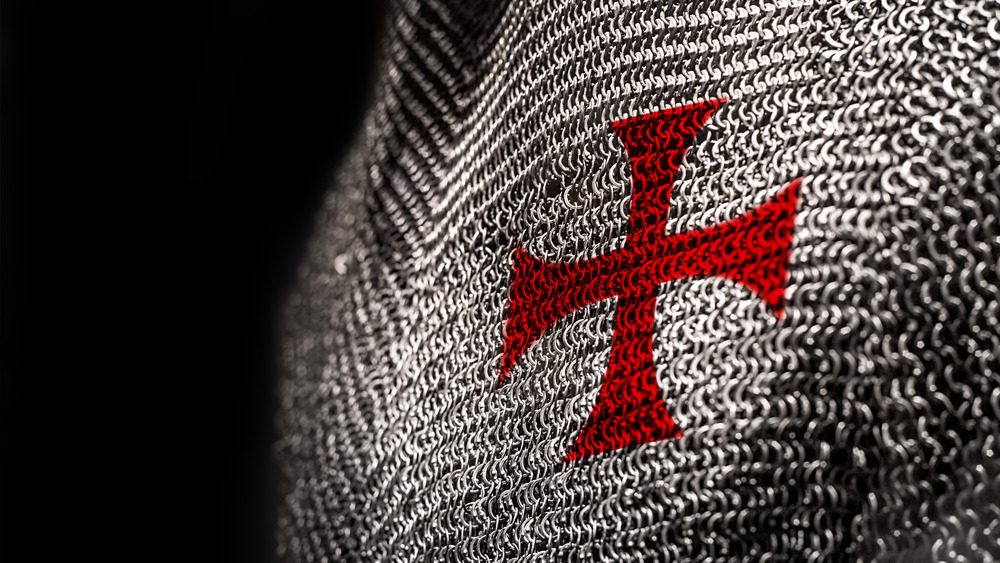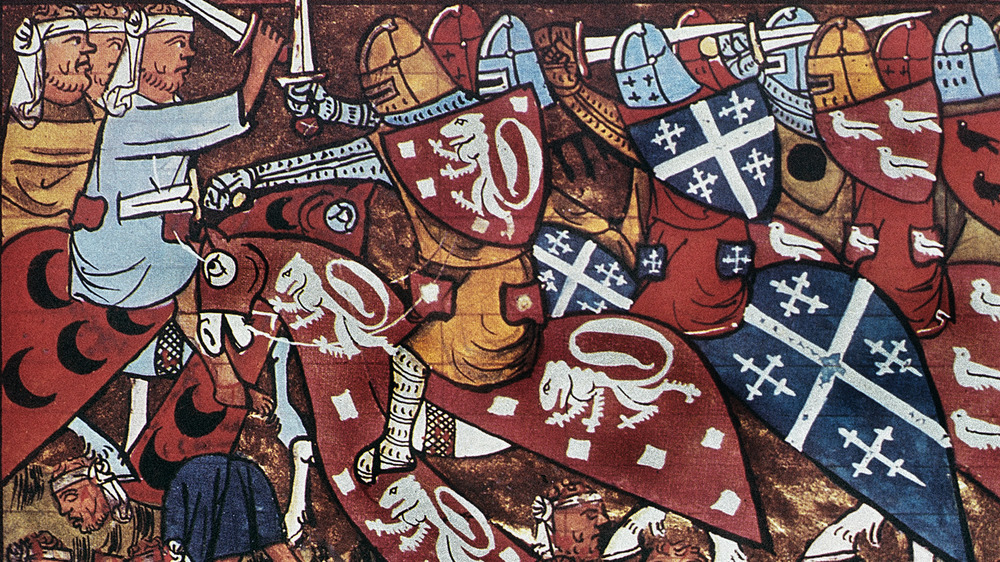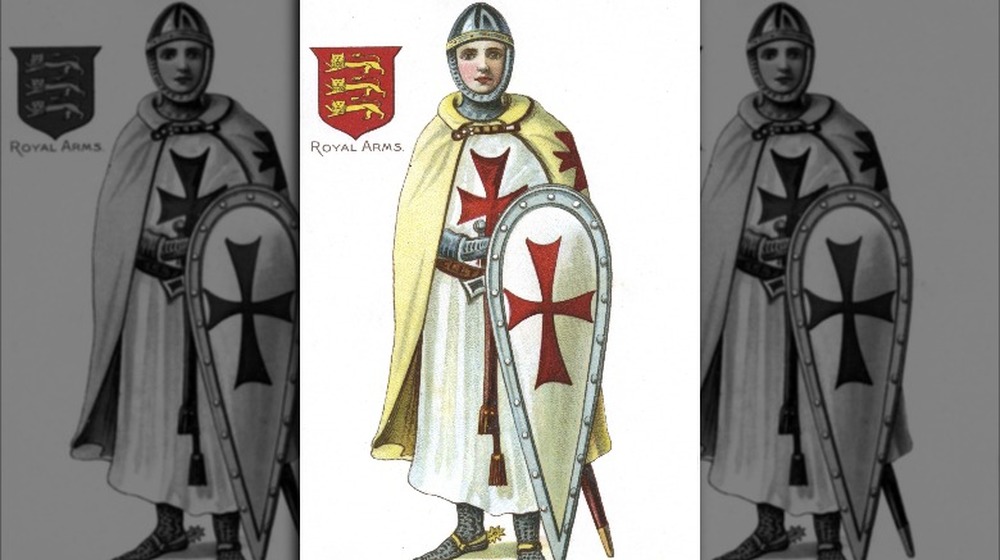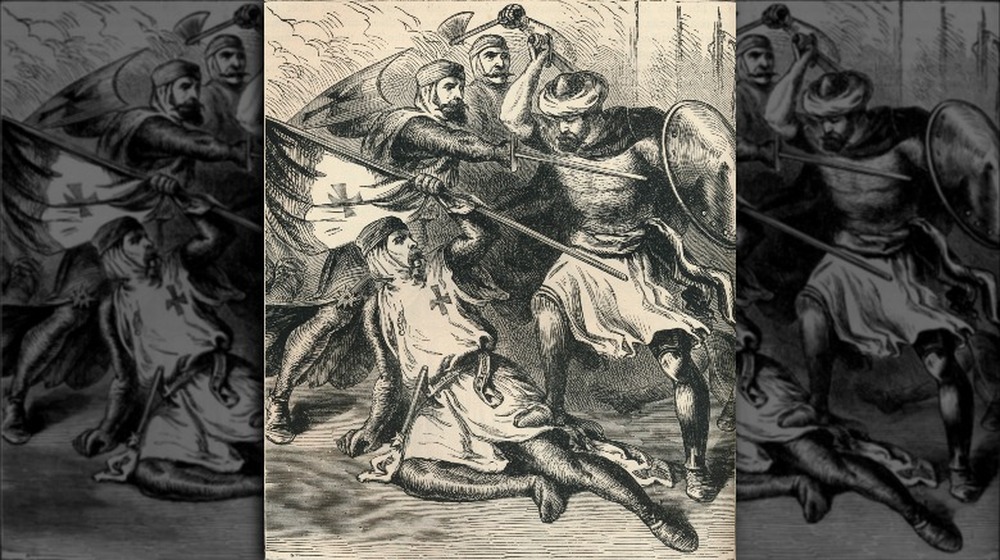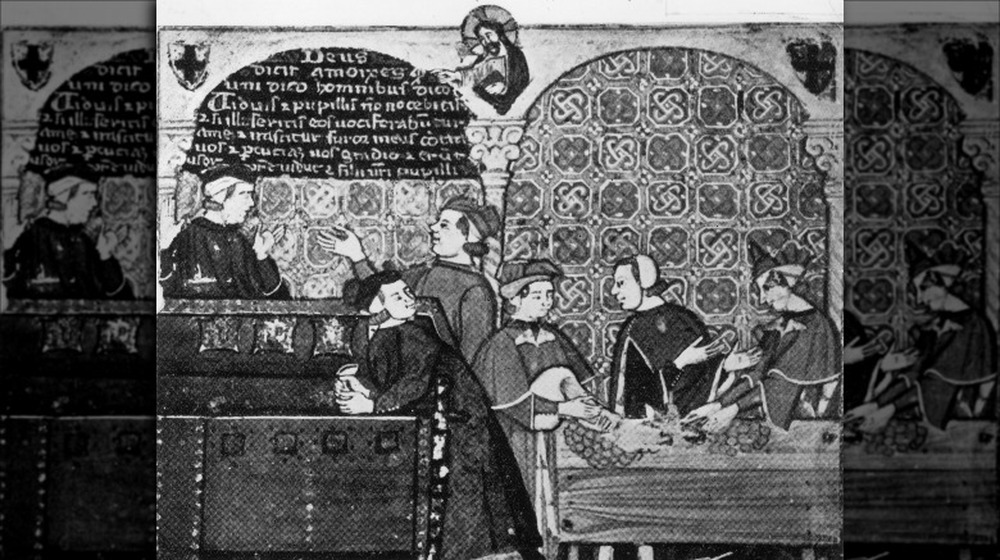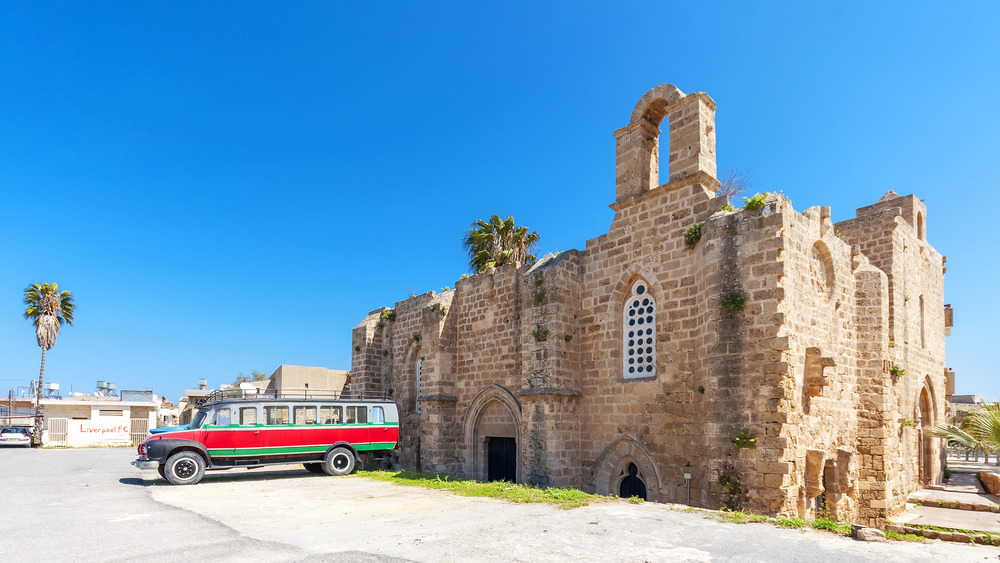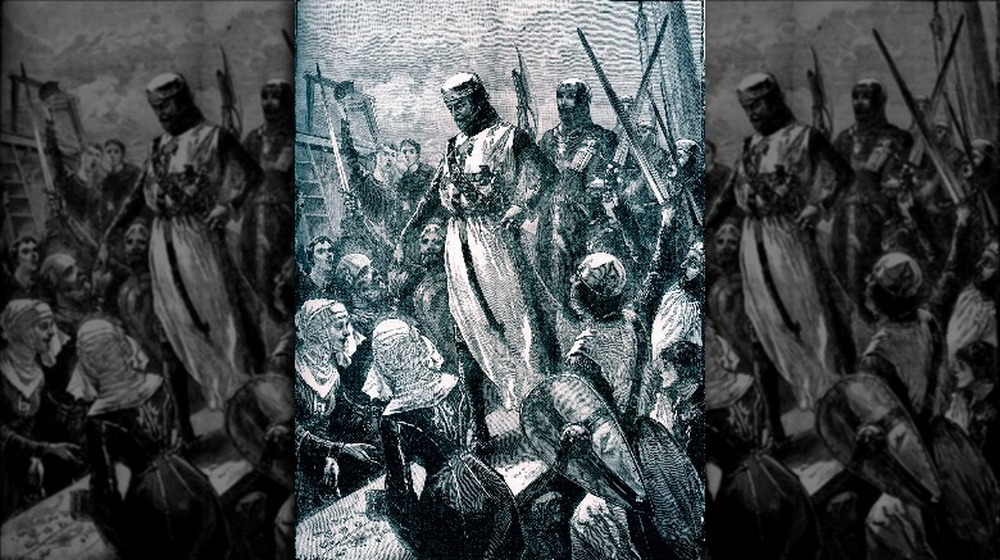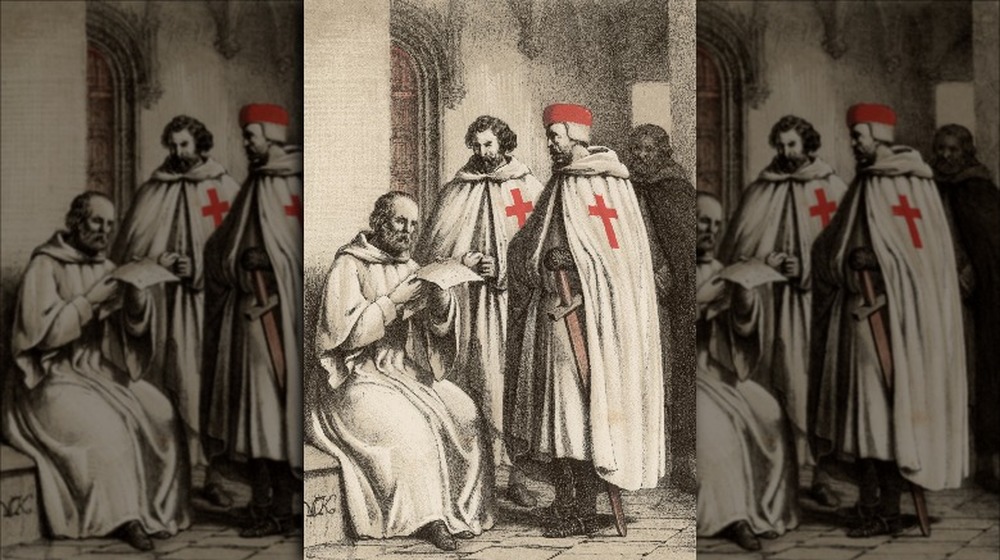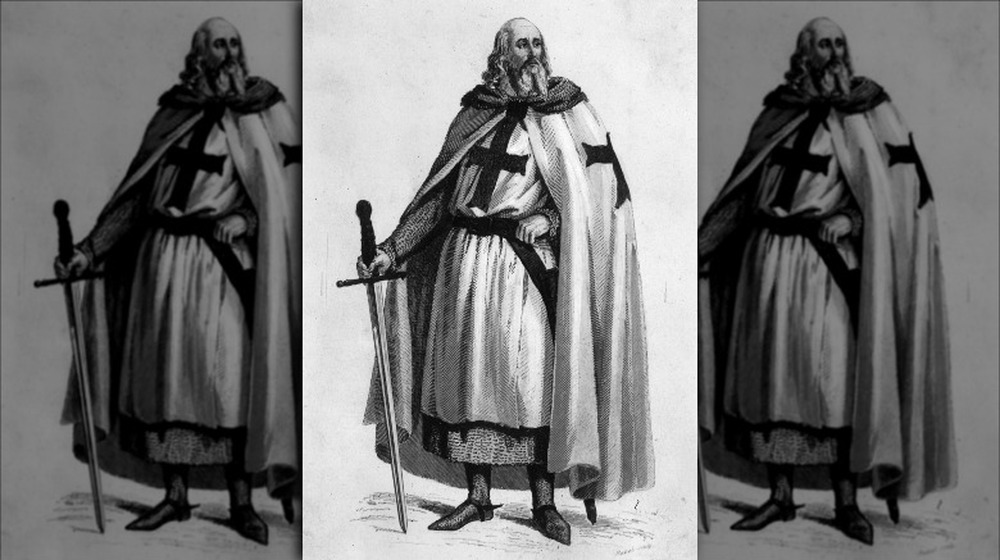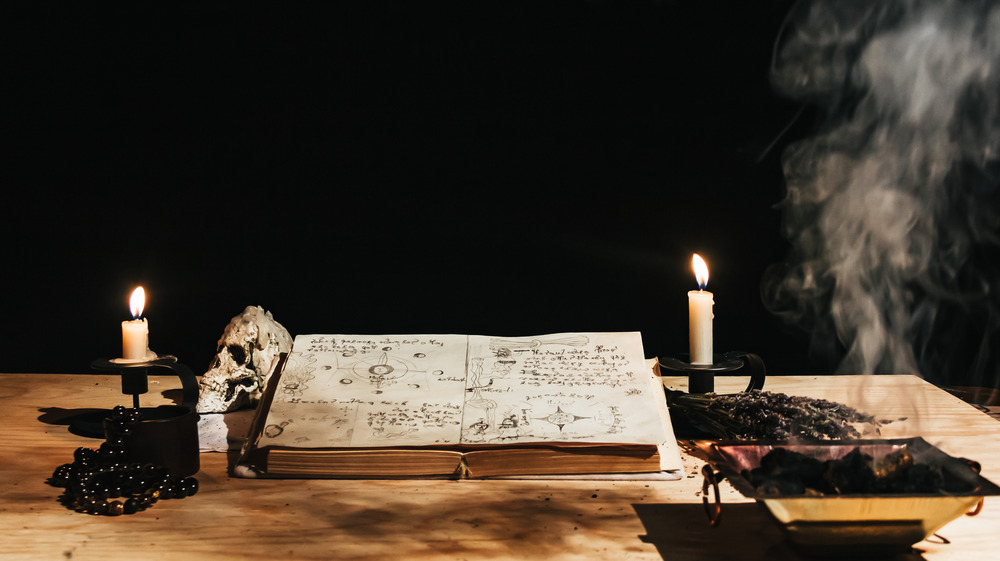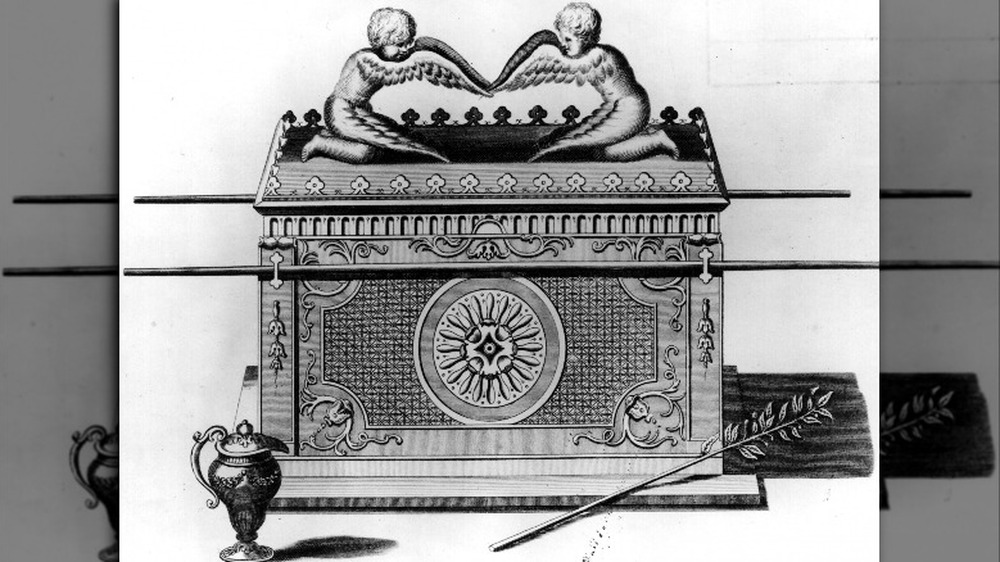Why The Templars Are The Most Powerful Secret Society In History
Ah, yes, secret societies. Everyone loves to talk about how little is actually known about them and hear about all the stories of just what they might be. The Freemasons, the Illuminati — it's such a crazy thought to imagine that, just maybe, lurking somewhere in the shadows, there's one group of people pulling all the strings, puppetmaster-ing every single major world event. It's a little terrifying, but at the same time, it's just so intriguing, and so it's hard not to wonder if maybe, it's all true.
But when you're talking secret societies, the idea of power always comes up. So which group is actually the most powerful or the most influential? Maybe it's the Freemasons — just take a look at the backside of the $1 bill (the Eye of Providence, anyone? That's got Masonic influence written all over it). Or maybe it's the Illuminati, whom conspiracy theorists love to say are at the center of every historical event, furthering their own goals without anyone else's knowledge. Or maybe it's the mysterious Bilderberg Group — a secret meeting of insanely influential people, all gathered together to discuss...something.
But when you go through all of history, the title of "most powerful" just might have to go to the Knights Templar, and there are some pretty good reasons as to why.
The Crusades created a need for bodyguards
The origins of the Knights Templar are incredibly humble and, frankly, not even all that mysterious. According to History, they basically just came about because of the Crusades.
The whole topic of the Crusades and how they happened is another long conversation, but the important part as it relates to the Templars is that Jerusalem was taken from Muslim hands by Christian armies around the year 1099. On the surface, that seemed great for Christendom, and pilgrims from Europe could take the journey to go and visit the holy city of Jerusalem. But the reality wasn't quite as straightforward. Really, that journey from mainland Europe to Jerusalem to the Holy Land was a dangerous undertaking, and it wasn't uncommon for pilgrims to be robbed — or even killed — as they passed through Muslim-controlled areas.
It was a problem that the French nobleman Hughues de Payens wanted to solve (via World History Encyclopedia), and so somewhere around 1118 or 1119, he created a group sworn to protect the Christian pilgrims. He coined his new brotherhood the Poor Fellow-Soldiers of Christ and the Temple of Solomon, later known as the Knights Templar or just "Templars," and thus one of history's most intriguing and powerful orders was born.
The rules for the Knights Templar were strict
Arguably, part of what allowed the Templars to become as powerful and successful as they were might've been their code of conduct. World History Encyclopedia likens them, to some degree, to a monastic order, and that's not entirely wrong. They took their vows upon entry and then abided by a set of guidelines (called the Rule — yes, with a capital "R").
That started with their clothing — a white cloak adorned with a red cross. According to History, white was a symbol of their purity and chastity, the exact opposite of the flashy armor usually associated with knights. Even something as simple as a belt was replaced with a wool cord — all the function without the fashion — and in the case that a cloak wasn't white, it was still a simple brown or black. No decorative flourishes, since they signified arrogance.
But that wasn't it for the rules. They were beholden to the word of their Grand Master — permission was required from their superiors to adjust their stirrups, go into town, or even bathe. Chastity was hugely important, and the topic of women was basically taboo — they couldn't talk about times they had spent with women or even kiss female members of their families. Mealtimes were regulated, too — meals taken together, two brothers to a bowl, and meat only every other day (to avoid corruption, apparently). Oh, and church services were mandatory, of course.
The Knights Templar were known as fierce warriors
Over time, the Templars started to garner a reputation as one of the most feared fighting units during the Crusades. History says that they were largely seen as absolutely fearless, and with a code that actually didn't permit them from retreating from battle, combined with an insane discipline, they were a force to be reckoned with.
World History Encyclopedia goes on to add that they were expertly trained with multiple weapons and exceedingly well equipped, and that was when their cavalry wasn't just decimating the enemy ranks. Dan Jones' The Templars: The Rise and Spectacular Fall of God's Holy Warriors paints them as a lynchpin in the Second Crusade, leading entire armies to battle and fighting on the front lines to conquer the city of Damascus — one of the most prominent cities in the region. Plus, they didn't just fight but also helped fund other military campaigns and battles (even if those didn't always end so well). People living at the time even went so far as to see them as something close to legendary.
And maybe that even went a little past just legendary, with the Templars becoming a force to be feared. Rulers of different countries actually started to see them as a legitimate military threat, one with too much experience and leeway. It was enough that European royalty might've eventually thought it best that the threat posed by the Templars was one that should be removed completely.
Financiers of the Crusades
Even though the Knights Templar started as exactly what their name implies — holy warriors — one of the biggest impacts they made wasn't actually made on the battlefield.
According to the BBC, the Templar's financial system functioned a lot like a private bank. Carrying a lot of money on the journey to Jerusalem was dangerous to pilgrims for all the obvious reasons. Instead, they could deposit money in a Templar bank in Europe, receive a letter of credit, and then show that letter in Jerusalem, where they could withdraw the money.
But the Templars also offered other financial services, too, aside from just a simple banking system, although a lot of those services were to their higher-profile clients. King Henry III planned to buy the island of Oleron, and the Templars acted as brokers to put that deal together. There was also a point in time where they acted as pawn brokers, by holding onto the crown jewels as security on a loan. Yes, the crown jewels were in Templar hands for a while.
They were also trusted with the financials of other groups. National Geographic explains that the pope used the Templars as tax collectors for a while, because they could move those funds to the Crusades. They were also used by English and French kings to move money or even put on boards to oversee complicated financial matters, because they were well known for their honesty and efficiency, as told by Eleanor Ferris.
The Knights Templar were ridiculously wealthy
The guidelines set out by the Knights Templar technically mandated that its members embrace poverty, but the reality didn't really look like that. The truth was quite the contrary — the Templars as a group were insanely rich.
Part of that came from their fights on the frontlines. Rules laid out by the pope meant that they could keep the riches they found from the lands they conquered (via The Knights Templar of North America). But another big part of it came from donations. History explains that patrons would gift them huge sums of money as a way to confirm their piety. Donating funds to the Templars essentially protected the donor's eternal soul, which, given the time period, was a pretty important thing to a lot of people. It just also happened to benefit the Templars. And on the plus side, National Geographic also adds that it was a way for anyone to prove their devotion without actually taking part in the fighting of the Crusades. A much safer alternative, on the whole.
Those donations also occasionally included plots of land, which the Templars could turn into further revenue streams, managing to use them as farmland or vineyards, among other things, which just went to further their wealth.
The Knights Templar owned a lot of land (including a whole island)
Aside from growing into one of the most financially wealthy groups in the medieval world, the Templars also managed to turn themselves into an incredibly property-rich group. According to National Geographic, at their height, they ended up owning lands all across Europe. Their estates were scattered through England and Ireland, as well as across mainland Europe (Spain, Germany, Italy, Hungary — you get the picture).
Aside from their lands in Europe, they also held onto a handful of locations in the Holy Land. History lists a bunch of them, castles and fortresses scattered in strategic locations, stretching as far north as Antioch (north-east of Cyprus), and nearly as far south as Egypt.
Speaking of the island of Cyprus, the Templars also owned that for a while. The whole island. CyprusScene explains that the Templars bought the island from the then-king of England, Richard the Lionheart (Erenow adds that Richard himself had been having some troubles with the island). That said, their rule didn't go well. The inhabitants of Cyprus resented the severe Templar rule and planned a massacre in 1192. Long story short — the Templars learned about the plot and slaughtered people in the streets (rather than be besieged in their stronghold). They ultimately gave the island back to Richard but retained their holdings on the island, some of them even returning in the late 1200s. Their ownership of the island was short, but it's an interesting fact.
The Knights Templar had friends in high places
The power of the Templars is also really well exemplified by the people they associated with, because while most of the individual Templars (save Grand Masters and a few others of note) aren't really named in the history books, they counted kings and popes among their allies.
That was really the case from the beginning. World History Encyclopedia tells how Baldwin II, the king of Jerusalem at the time, took an immediate liking to the order, giving them the use of his palace on Temple Mount in 1120 — better known as "The Temple of Solomon" and the place where the Templars first got their name. About a decade later, they were officially recognized by the Catholic Church and Pope Honorius II and also had the backing of Bernard of Clairvaux, a prominent French abbot, who wrote texts in their favor (via History).
Their connections only grew from there. They had close ties to English royalty, and Richard the Lionheart (pictured above) in particular, who sold Cyprus to them but also personally called on them to be his tithe collectors (via Erenow). National Geographic adds that they were especially close with French kings as well, going out of their way to help them. Louis IX was short on funds, so the Templars saw to it that they played a role in getting his armies to Egypt. Then, when he was captured, the Templars again intervened, this time to pay his ransom.
They answered to (almost) no authority
Here's the part that gets really crazy, because what really sets the Templars apart from other secret societies is their relationship to the law. See, it's not that far of a stretch to say that the Freemasons, for example, would still have to follow the law of whatever country they were in at the time (obviously — the law is the law). But the Templars didn't have to deal with that.
According to History, the Templars were sort of an oddity for the medieval world, but with papal backing came a papal bull in 1139, called Omne Datum Optimum (via The Knights Templar of North America). The language is flowery, but it heaps a lot of praise on the Templars while intimately tying them to the power of the pope. And with that power came privilege.
They alone were entitled to any of the spoils of war which they earned while fighting against the Muslim armies. None of that had to go back to any other country, and the Templars could use those riches as they saw fit. They were completely exempt from paying any sort of taxes, and their papal protection essentially meant that they answered to almost no one. They weren't held to the rule of any kind of local authority — kings, queens, emperors, it didn't matter — and only had to listen to the word of the pope. They were, in a way, almost above the law. Talk about powerful.
The fall of the Knights Templar
By the late 12th century, the Crusades were starting to lose steam. History explains that Muslim armies finally took back Jerusalem, and over the next century, crusader refuges fell one by one, with the Templars themselves also losing their foothold in the Holy Land. Support for the Crusades dwindled, which let criticism of the Templars rise. People began to doubt their intentions and fear their influence, as explained by World History Encyclopedia, thinking that they were abusing funds, among other things.
King Philip IV of France was the one who acted on those accusations and vowed to bring them down (probably also because he was indebted to them, and they refused him further loans). In October 1307, he rounded up a bunch of French Templars (including their Grand Master, Jacques de Molay, pictured above), arresting and torturing them until they confessed to a laundry list of sins, including heresy, sodomy, and financial corruption (via History).
It's hard to say whether any of those confessions were true — they came under the weight of torture — but in the end, it didn't really matter. In 1310, a trial led to over 50 Templars being burned at the stake, and in 1312 Philip pressured Pope Clement V into officially dissolving the Templars, even though that was for reasons of reputation, not guilt. The final nail in the coffin came in 1314, when dozens of Templars — de Molay included — were executed for those earlier confessions.
Do they really count as a secret society?
Honestly, it seems kind of worth noting that, even though the modern perspective sees the Templars as a secret society, it wasn't like their existence was ever doubted back in the day. After all, it's hard to think that a well-oiled military machine who could help facilitate wars would really be able to go completely undetected and under the radar.
But they still fit the profile of a secret society, despite the renown they won in their time. And even if that was sort of unintentional. Really, they just wanted privacy, but it wasn't like they were really trying to hide (via Erenow). Their initiation rituals, in particular, really came under fire. Friends and family weren't invited to them, and of course that made others believe that the practices were suspect. For a while, it was easy to believe that said initiation ritual included spitting on the cross and denying Christ (among other things), because of confessions made under torture. Really, though, the ritual was nothing near that — just a series of questions and vows.
Still, though, questions abound, even as recently as 2017. The Caynton Caves were discovered and photographed, showing the world a labyrinth of carved caverns (via Daily Mail). It's assumed that the caves were used by the Templars, but to what end? Some sort of secret religious ritual, probably, but the details aren't really there.
A modern fascination with the Knights Templar
Despite having been dissolved in the early 14th century, the Knights Templar still manage to capture the wonder and imagination of the modern world, and, really, that seems to speak to a very particular kind of power, even if that's not political influence or military might. Even 700 years after the death of the last Grand Master, myths and legends still abound.
Conspiracy theorists can have a field day with questions over the relics the Templars may or may not have had in their possession. No, they didn't have the Shroud of Turin, the Holy Grail, the Ark of the Covenant, or actual pieces of the cross from the crucifixion (via History) in their hands. But it's fascinating to wonder if they did.
To go to something a bit more grounded, there are myths of a Templar treasure hoard, taken to some mysterious place just before the persecution they faced in the 1300s (via History). The Templar fleet did disappear at the time, but to where? And with what? Maybe to Scotland, where some people think they might've inspired the Freemasons, as History explains?
Basically, the Templars have lived on for centuries since their official dissolution, whether through the creation of contemporary branches, works of fiction like The Da Vinci Code or the Assassin's Creed franchise, or through the intrigue of scholars and anyone who likes a little history. It's a pretty cool legacy, to say the least.
